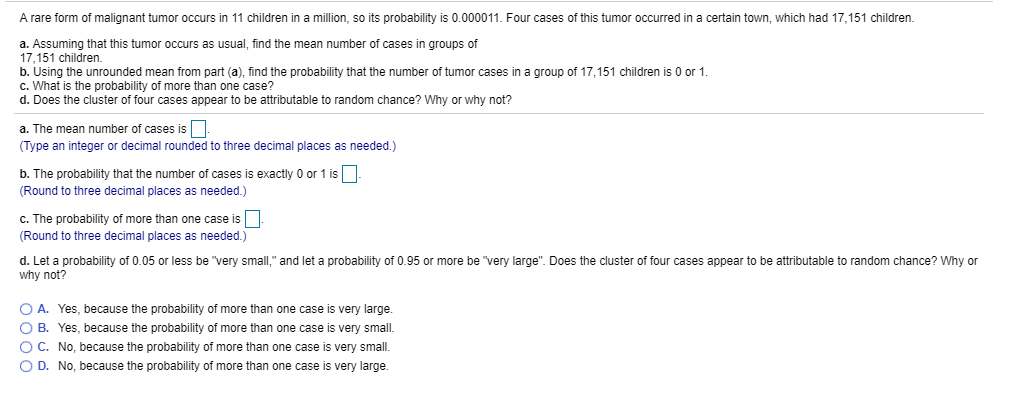A rare form of malignant tumor occurs in 11 children in a million, so its probability is 0.000011. Four cases of this tumor occurred in a certain town, which had 17,151 children. that this tumor occurs as usual, find the mean number of cases in groups of 7 151 children b. Using the unrounded mean from part (a), find the probability that the number of tumor cases in a group of 17,151 children is 0 or 1. c. What is the probability of more than one case? d. Does the cluster of four cases appear to be attributable to random chance? Why or why not? a. The mean number of cases is (Type an integer or decimal rounded to three decimal places as needed.) f cases is exactly 0 or 1 is b. The probability that the number (Round to three decimal places as needed.) c. The probability of more than one case is (Round to three decimal places as needed.) d. Let a probability of 0.05 or less be "very small," and let a probability of 0.95 or more be "very large". Does the cluster of four cases appear to be attributable to random chance? Why or why not? O A. Yes, because the probability of more than one case is very large .... .. O B. Yes, because the probability of more than one case is very small. O C. No, because the probability of more than one case is very small. O D. No, because the probability of more than one case is very large.
A rare form of malignant tumor occurs in 11 children in a million, so its probability is 0.000011. Four cases of this tumor occurred in a certain town, which had 17,151 children. that this tumor occurs as usual, find the mean number of cases in groups of 7 151 children b. Using the unrounded mean from part (a), find the probability that the number of tumor cases in a group of 17,151 children is 0 or 1. c. What is the probability of more than one case? d. Does the cluster of four cases appear to be attributable to random chance? Why or why not? a. The mean number of cases is (Type an integer or decimal rounded to three decimal places as needed.) f cases is exactly 0 or 1 is b. The probability that the number (Round to three decimal places as needed.) c. The probability of more than one case is (Round to three decimal places as needed.) d. Let a probability of 0.05 or less be "very small," and let a probability of 0.95 or more be "very large". Does the cluster of four cases appear to be attributable to random chance? Why or why not? O A. Yes, because the probability of more than one case is very large .... .. O B. Yes, because the probability of more than one case is very small. O C. No, because the probability of more than one case is very small. O D. No, because the probability of more than one case is very large.
College Algebra
7th Edition
ISBN:9781305115545
Author:James Stewart, Lothar Redlin, Saleem Watson
Publisher:James Stewart, Lothar Redlin, Saleem Watson
Chapter9: Counting And Probability
Section: Chapter Questions
Problem 14T: An unbalanced coin is weighted so that the probability of heads is 0.55. The coin is tossed ten...
Related questions
Question

Transcribed Image Text:A rare form of malignant tumor occurs in 11 children in a million, so its probability is 0.000011. Four cases of this tumor occurred in a certain town, which had 17,151 children.
that this tumor occurs as usual, find the mean number of cases in groups of
7 151 children
b. Using the unrounded mean from part (a), find the probability that the number of tumor cases in a group of 17,151 children is 0 or 1.
c. What is the probability of more than one case?
d. Does the cluster of four cases appear to be attributable to random chance? Why or why not?
a. The mean number of cases is
(Type an integer or decimal rounded to three decimal places as needed.)
f cases is exactly 0 or 1 is
b. The probability that the number
(Round to three decimal places as needed.)
c. The probability of more than one case is
(Round to three decimal places as needed.)
d. Let a probability of 0.05 or less be "very small," and let a probability of 0.95 or more be "very large". Does the cluster of four cases appear to be attributable to random chance? Why or
why not?
O A. Yes, because the probability of more than one case is very large
.... ..
O B. Yes, because the probability of more than one case is very small.
O C. No, because the probability of more than one case is very small.
O D. No, because the probability of more than one case is very large.
Expert Solution
This question has been solved!
Explore an expertly crafted, step-by-step solution for a thorough understanding of key concepts.
This is a popular solution!
Trending now
This is a popular solution!
Step by step
Solved in 4 steps with 3 images

Recommended textbooks for you

College Algebra
Algebra
ISBN:
9781305115545
Author:
James Stewart, Lothar Redlin, Saleem Watson
Publisher:
Cengage Learning

Holt Mcdougal Larson Pre-algebra: Student Edition…
Algebra
ISBN:
9780547587776
Author:
HOLT MCDOUGAL
Publisher:
HOLT MCDOUGAL


College Algebra
Algebra
ISBN:
9781305115545
Author:
James Stewart, Lothar Redlin, Saleem Watson
Publisher:
Cengage Learning

Holt Mcdougal Larson Pre-algebra: Student Edition…
Algebra
ISBN:
9780547587776
Author:
HOLT MCDOUGAL
Publisher:
HOLT MCDOUGAL
